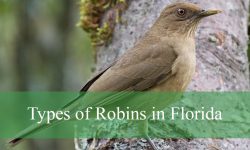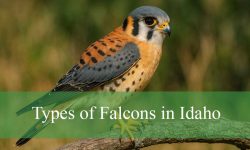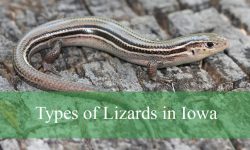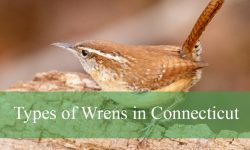Texas is home to both native and introduced species of starlings, making it an intriguing state for birdwatchers interested in this intelligent and adaptable family of birds. While only a handful of starling species are regularly seen, their presence highlights the diversity of Texas habitats—from bustling cities and agricultural plains to coastal wetlands and open woodlands. These birds are known for their remarkable vocal mimicry, social behavior, and striking iridescent plumage that shines beautifully in the sunlight.
Among all the starlings found in the state, the European Starling remains the most widespread and dominant species. It has firmly established itself across Texas, thriving in both urban and rural environments. Though introduced from Europe over a century ago, it has adapted seamlessly to the Texan climate and is now a familiar sight in city parks, farmlands, and even residential backyards. Its resilience and intelligence allow it to compete successfully with native birds for food and nesting sites.
However, Texas birders occasionally report sightings of rare or accidental starlings, including exotic species like the Common Myna or Rosy Starling, likely escaped from captivity or blown in by storms. These uncommon appearances add excitement to birdwatching, offering a chance to spot something extraordinary amid familiar flocks. Below are the key starling species and subspecies you may encounter in the Lone Star State, from the abundant to the unexpected.
Types of Starlings Found in Texas
European Starling (Sturnus vulgaris)
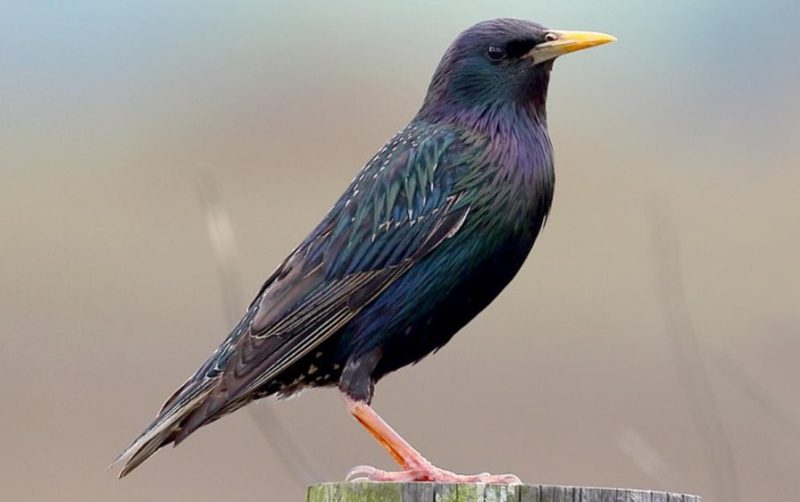
The European Starling (Sturnus vulgaris) is the most common and widespread starling in Texas. Originally introduced from Europe in the late 1800s, it quickly adapted to life across North America. Adults measure 7.5 to 9 inches long, with glossy black plumage that shines purple, green, and blue under sunlight, making them stand out in any flock.
During winter, their feathers develop white speckles, giving them a dotted, frosty appearance that differs from their sleek summer look. Their bills also change from yellow to dark brown, making seasonal identification easier. These subtle shifts make the European Starling one of the most visually interesting birds found year-round in Texas.
They thrive in both urban and rural environments, from city parks and farmlands to residential areas. Their diet includes insects, fruits, grains, and seeds, allowing them to survive almost anywhere. They often gather in large groups, foraging together noisily across open spaces.
In Texas, European Starlings live year-round, especially common in Austin, Dallas, Houston, and the Gulf Coast. They often compete with native species like bluebirds and woodpeckers for nesting cavities, which has earned them a reputation as an invasive but intelligent bird.
Their most fascinating behavior is the murmuration—large flocks swirling in perfect coordination across the evening sky. These breathtaking aerial displays, common in winter, remain one of the most memorable sights for Texas birdwatchers.
Common Myna (Acridotheres tristis)
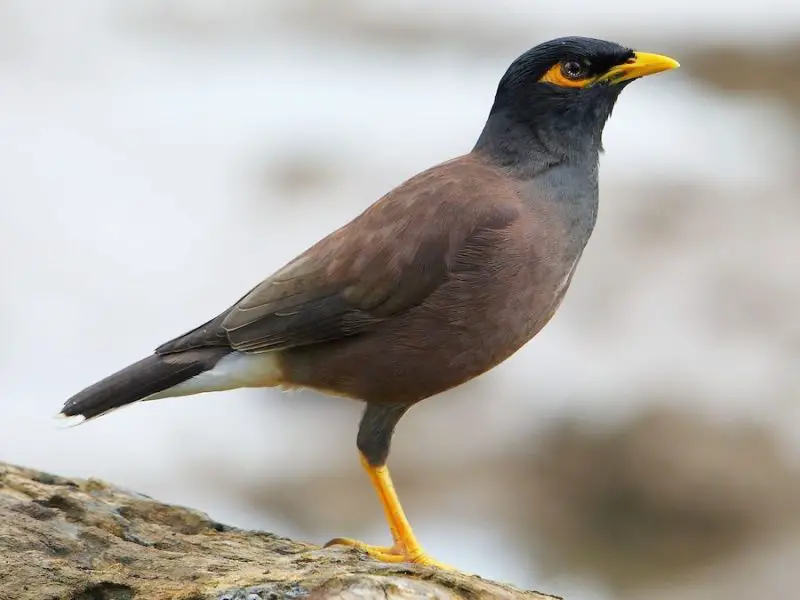
The Common Myna (Acridotheres tristis) is a rare accidental species occasionally spotted in Texas. Originally native to South Asia, it has been successfully introduced to many parts of the world, including Hawaii, Australia, and Florida. This adaptable bird measures around 9–10 inches and is instantly recognizable by its brown body, black head, and bright yellow eye patches and legs, giving it a bold and expressive look.
Its vocal nature and confident behavior make the Common Myna easy to identify, as it often walks rather than hops and emits a series of loud, chattering calls. These traits, combined with its distinctive plumage, make it stand out among native Texan birds. Mynas are also known for their intelligence and mimicry, sometimes imitating the sounds of other birds or even human speech.
Though not a permanent resident of Texas, scattered records exist, particularly in southern and coastal areas. These birds are often escaped pets or wanderers from nearby populations, capable of adapting quickly to local environments. They are comfortable living near humans, often nesting in buildings, street signs, or tree cavities.
The Common Myna is omnivorous, feeding on insects, fruits, grains, and food scraps. Its flexible diet allows it to thrive in urban settings, farmland, and open countryside. However, in regions where it has become established, the species is sometimes viewed as a pest due to its competition with native birds for nesting sites.
In Texas, the Common Myna remains rare and sporadic, but its global resilience and adaptability suggest that sightings could become more frequent in the future. Birdwatchers in South Texas, especially near Houston, Corpus Christi, and Brownsville, should keep watch for this striking bird that brings a touch of tropical character to the Texan landscape.
Chestnut-tailed Starling (Sturnia malabarica)
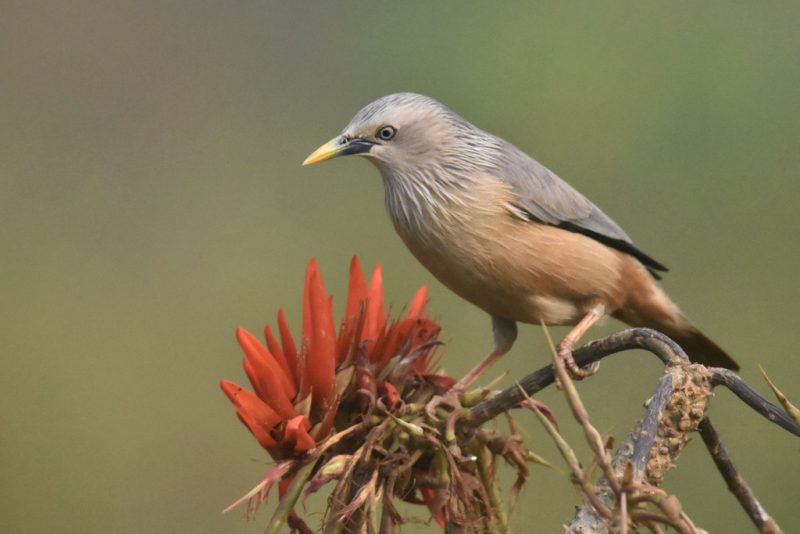
The Chestnut-tailed Starling (Sturnia malabarica), also known as the Grey-headed Myna, is a rare accidental visitor to Texas. This elegant bird is native to Southeast Asia, where it inhabits open forests and farmlands. Adults can be recognized by their soft gray head, whitish underparts, and chestnut-colored tail and wings, giving them a graceful and warm-toned appearance unlike any other starling in the state.
In its native range, the Chestnut-tailed Starling is often found in small social groups, feeding on fruits, berries, and insects in the tree canopy. Its gentle, musical calls and subtle color pattern make it a favorite among birdwatchers in Asia. These birds adapt well to cultivated landscapes and are often seen near villages or orchards, where food sources are abundant.
In Texas, this starling is considered a non-native escapee, sometimes reported around southern Texas or Houston. Most sightings are believed to come from captivity escapes rather than natural migration, as the species is occasionally kept as a pet for its beauty and song. Despite the lack of a breeding population, each sighting adds intrigue to the state’s birding records.
The Chestnut-tailed Starling’s chestnut and silver-gray plumage makes it easily distinguishable from the darker, glossy look of the European Starling. When spotted, it immediately draws attention for its calm demeanor and striking coloration. Its rarity in the wild makes every confirmed observation a noteworthy event for local birders.
Because appearances are extremely uncommon, any observation of this species in Texas should be carefully documented with photos and details, then reported to Audubon Texas or Texas eBird. Verified sightings contribute valuable information about potential introductions and help track the presence of exotic birds in the region.
Rosy Starling (Pastor roseus)
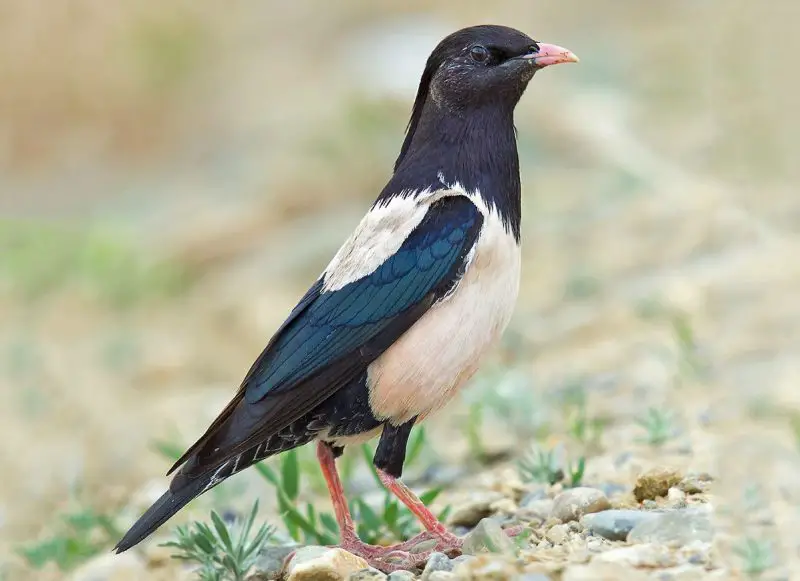
The Rosy Starling (Pastor roseus), also known as the Rose-colored Starling, is an exceptionally rare visitor to Texas and one of the most visually stunning members of the starling family. Native to Europe and Central Asia, this species stands out with its pale pink body, glossy black head, and iridescent black wings and tail. Its elegant contrast of colors and lively behavior make it one of the most sought-after vagrant species for birdwatchers.
During certain years, the Rosy Starling undertakes large-scale irruptions, wandering far from its typical range due to food shortages or strong migratory winds. These events occasionally push a few individuals into unexpected regions, including Alaska, Florida, and Texas. In Texas, sightings are exceedingly rare but have been reported mostly along the southern and coastal regions, where the mild climate and abundant food offer temporary refuge.
In its native breeding areas, the Rosy Starling is known for its social and nomadic habits, forming large colonies that move together in search of food. It primarily feeds on insects—especially locusts—and soft fruits, making it a beneficial species in controlling agricultural pests. Its feeding behavior is active and acrobatic, often involving short, darting flights between foraging spots.
When spotted in Texas, the Rosy Starling’s graceful pink-and-black plumage and restless movements immediately set it apart from native species like grackles and starlings. Most sightings occur after storms or strong winds, which may disorient migrating birds and carry them far off their normal paths. Such rare appearances are thrilling moments for local birders.
Although the Rosy Starling has not established any stable population in Texas, it remains a symbol of rarity and beauty for bird enthusiasts. Observers are encouraged to report confirmed sightings to organizations like Texas eBird or Audubon Texas, helping document these exceptional events and enrich the understanding of global bird migration patterns.
Asian Pied Starling (Gracupica contra)
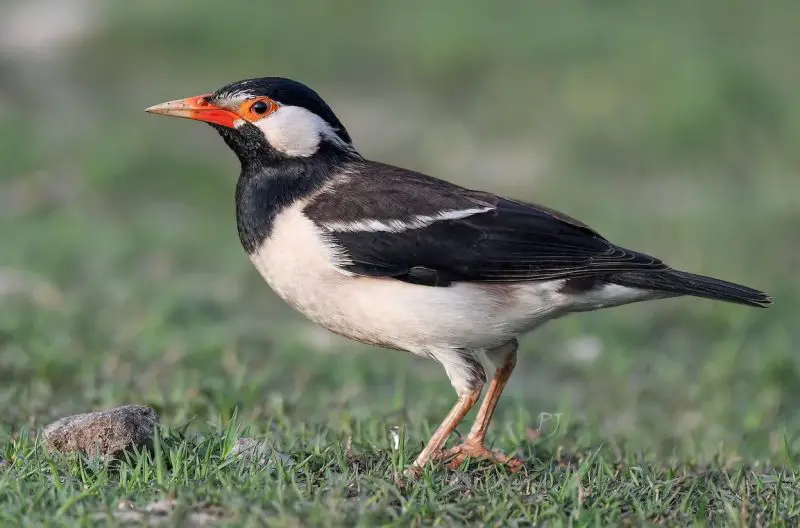
The Asian Pied Starling (Gracupica contra), also known as the Pied Myna, is another occasional escaped cage bird that has been reported in Texas. Native to the Indian subcontinent, this striking bird is instantly recognizable by its contrasting black-and-white plumage, orange-red eye patches, and yellow-orange bill. Slightly smaller than the Common Myna, it stands out with its sharp coloration and loud, expressive voice.
In its native range, the Asian Pied Starling is highly social and vocal, often found in pairs or small flocks around villages, farms, and open fields. Its calls are varied and musical, ranging from whistles to chattering notes, which make it a popular bird in aviculture. Because of this popularity, individuals sometimes escape from captivity, leading to occasional sightings far from their homeland.
In Texas, a few records exist near Houston and San Antonio, regions that host many exotic bird enthusiasts and breeders. While these escaped individuals may survive for short periods, they rarely establish stable populations. The species favors warm, humid environments, which means it can endure mild seasons but often struggles during colder Texas winters.
The Asian Pied Starling’s omnivorous diet—consisting of insects, fruits, and leftover human food—makes it a capable survivor wherever it appears. However, its inability to withstand long cold spells prevents it from expanding naturally in the state. If environmental conditions were ever to become more stable and warm, it could potentially compete with native starlings and grackles for nesting spaces.
For now, this elegant black-and-white bird remains a rare curiosity in Texas, most often seen in aviaries or suburban neighborhoods after accidental escapes. Birdwatchers who spot one are encouraged to document and report sightings to local birding authorities, as these isolated records contribute valuable data to understanding how exotic species occasionally appear and adapt within Texas’s diverse ecosystems.
Starlings vs. Blackbirds in Texas
Many birdwatchers confuse starlings with blackbirds due to their similar size and dark plumage. However, there are distinct differences:
- Starlings have short tails, pointed wings, and a straight yellow bill (in breeding plumage).
- Blackbirds, like the Great-tailed Grackle or Red-winged Blackbird, have longer tails and thicker bills.
- Starlings often move in large synchronized flocks (murmurations), unlike blackbirds, which form looser groups.
Recognizing these key traits can help distinguish between the two, especially when observing mixed flocks during winter.
Best Time to See Starlings in Texas
You can observe European Starlings year-round in Texas, though they are most active and visible during spring and early summer when breeding occurs. They often nest in cavities, vents, or street signs, and you’ll hear their loud, varied songs from open fields and suburban neighborhoods.
During fall and winter, large roosts form, sometimes with tens of thousands of birds, especially near agricultural areas and city outskirts. This is also the best time to witness their murmurations—massive, swirling flocks performing aerial displays at dusk.
FAQs About Starlings in Texas
Are starlings native to Texas?
No, European Starlings are not native to Texas or North America. They were introduced from Europe in the 19th century and have since become widespread across the continent.
Do starlings harm native birds in Texas?
Yes. European Starlings are known to compete aggressively for nesting cavities, displacing native birds such as Eastern Bluebirds, Purple Martins, and woodpeckers. They are considered invasive species in Texas.
Where can I see starling murmurations in Texas?
Large murmurations can often be seen in North Texas, Central Texas, and the Gulf Coast region, particularly near farmland or open plains around Austin, Waco, and Dallas–Fort Worth during late fall and winter evenings.
Do starlings migrate in Texas?
Most European Starlings in Texas are resident year-round, though some northern populations may migrate south in winter, temporarily increasing their numbers in the state.
How can I attract or deter starlings?
To attract starlings, offer suet cakes, mealworms, or open water sources. However, many birders prefer to deter them by using starling-proof feeders and reducing cavity access, since they often compete with native species.

